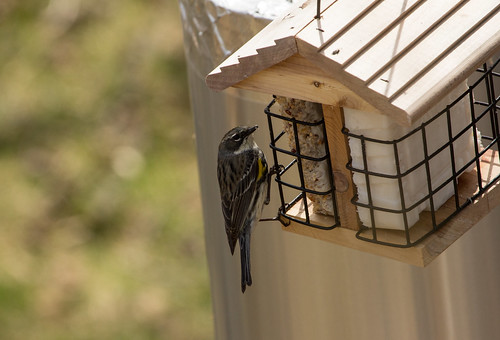
The spring of 2014 has been colder than usual, just like our winter was. Birds that winter in the southern states can mosey north with good weather patterns, so can start turning up in north country as early as late February or delay their arrival until much later. This year I heard my first robin on April 7, when there was still some snow on the ground and worms hadn’t emerged yet. The few robins that arrived in April ate leftover mountain ash berries. They didn’t become abundant here until May.
Birds that winter in the tropics have no access to The Weather Channel to learn about weather conditions up here. Their timing in leaving the tropics is related to day length, so even in a late spring, they arrive in the Gulf States roughly at the same time each year. Once they are in North America, they can be more flexible, the vast bulk of them moving when night flight conditions are ideal, and then waiting to migrate again until they’ve replenished their body fat. Ideal conditions for getting an abundance of food right when leaves are opening. Leaves just emerging from their buds are exceptionally tender until the cell walls firm up and any waxy protective outer layers on the leaves develop. Hatching caterpillars need this soft food, so they hatch right when leaves are opening, and warblers fuel their migration on this abundant food source.
During a year characterized by mild conditions and early leaf-out throughout their migratory range, warblers may start arriving in the north early. This year, spring was a little late as they arrived along the Gulf, but caught up soon enough, and the birds made it to the Midwest before the late leaf-out slowed them down.
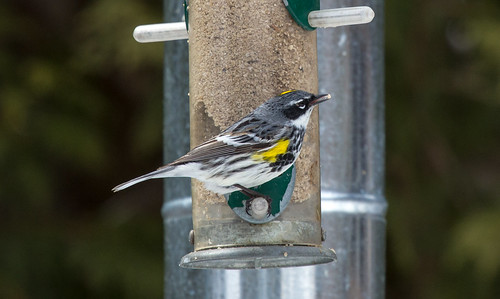
Even the tiniest warblers that breed up here have to be well adapted to cold temperatures. They can hold in their body heat thanks to their built-in down underwear. The trick for surviving extreme cold is to warm that body in the first place, which is accomplished by the bird’s metabolic furnace, burning the calories in food. Migrants arriving before appropriate food for them is available usually die, either of starvation or from predators when desperately searching for food. Last year we lost a lot of birds during our late, frigid spring.

So many warblers arrived before trees had leafed out that they were searching for food in strange places—many of us got photos of treetop species desperately searching for food on the ground along Lake Superior beaches.
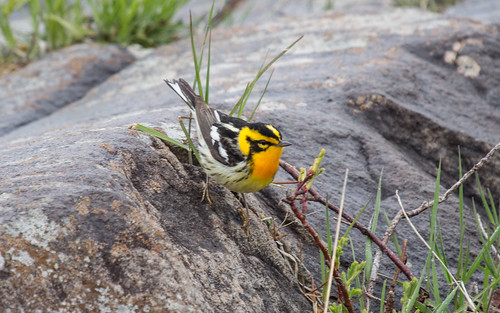
Some warblers kept going by exploiting bird feeders. They’re not adapted to digesting seeds or even suet well, but the calorie boost was enough to tide them over for the duration. Those birds ostensibly survived in good numbers, and broadened their search pattern for food to include bird feeders, so this year gravitated to feeders again. Warblers tend to observe one another as one way of identifying food sources, so when a few Yellow-rumped Warblers turned up at feeders, suddenly others started showing up, too.
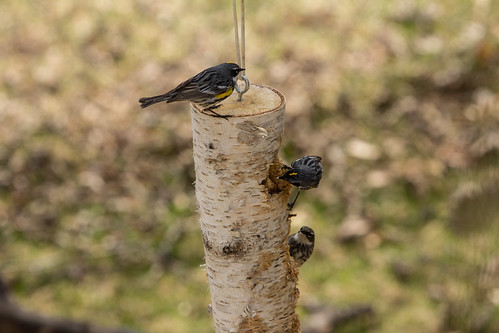
And so for several weeks, I’ve been inundated with emails from people wondering about the warblers at their feeders. Most of them have been yellow-rumps, for two different reasons. These tend to be among the very first migrants, putting them at risk of arriving before their normal insect food is available, and have the most flexible digestive system. I’ve had as many as 10 yellow-rumps at my feeders at one time. Other warblers may at least check out what the yellow-rumps are eating, and so several other species have also been seen at feeders. In my yard, Black-and-white Warblers and American Redstarts have checked out the feeders momentarily, but by the time I first saw them, leaves were opening and they pretty much stuck to normal food.
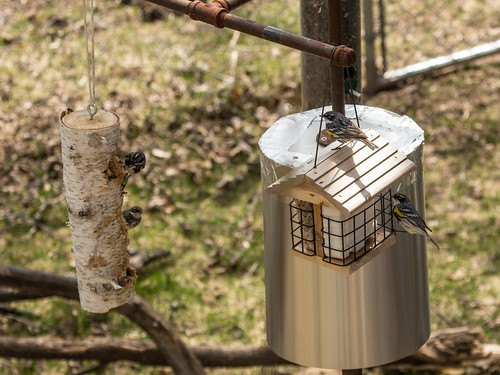
By May 16, buds were opening like mad in my neighborhood, so unless the weather takes a turn for the worst, the bulk of warblers should be able to get more normal food than they did last year. But now that so many yellow-rumped warblers have figured out bird feeders, we may start seeing them and other insectivores more frequently in our backyards during migration. It’s always hard to predict what birds are going to do, but backyard observations over the next few years should prove interesting.
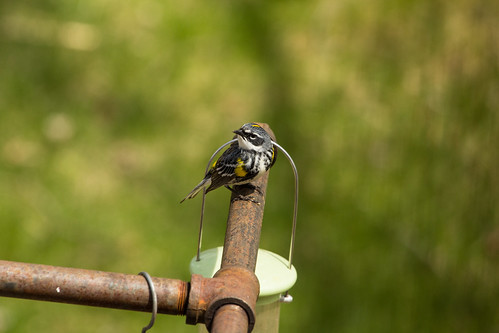
 The spring of 2014 has been colder than usual, just like our winter was. Birds that winter in the southern states can mosey north with good weather patterns, so can start turning up in north country as early as late February or delay their arrival until much later. This year I heard my first robin on April 7, when there was still some snow on the ground and worms hadn’t emerged yet. The few robins that arrived in April ate leftover mountain ash berries. They didn’t become abundant here until May.
Birds that winter in the tropics have no access to The Weather Channel to learn about weather conditions up here. Their timing in leaving the tropics is related to day length, so even in a late spring, they arrive in the Gulf States roughly at the same time each year. Once they are in North America, they can be more flexible, the vast bulk of them moving when night flight conditions are ideal, and then waiting to migrate again until they’ve replenished their body fat. Ideal conditions for getting an abundance of food right when leaves are opening. Leaves just emerging from their buds are exceptionally tender until the cell walls firm up and any waxy protective outer layers on the leaves develop. Hatching caterpillars need this soft food, so they hatch right when leaves are opening, and warblers fuel their migration on this abundant food source.
During a year characterized by mild conditions and early leaf-out throughout their migratory range, warblers may start arriving in the north early. This year, spring was a little late as they arrived along the Gulf, but caught up soon enough, and the birds made it to the Midwest before the late leaf-out slowed them down.
The spring of 2014 has been colder than usual, just like our winter was. Birds that winter in the southern states can mosey north with good weather patterns, so can start turning up in north country as early as late February or delay their arrival until much later. This year I heard my first robin on April 7, when there was still some snow on the ground and worms hadn’t emerged yet. The few robins that arrived in April ate leftover mountain ash berries. They didn’t become abundant here until May.
Birds that winter in the tropics have no access to The Weather Channel to learn about weather conditions up here. Their timing in leaving the tropics is related to day length, so even in a late spring, they arrive in the Gulf States roughly at the same time each year. Once they are in North America, they can be more flexible, the vast bulk of them moving when night flight conditions are ideal, and then waiting to migrate again until they’ve replenished their body fat. Ideal conditions for getting an abundance of food right when leaves are opening. Leaves just emerging from their buds are exceptionally tender until the cell walls firm up and any waxy protective outer layers on the leaves develop. Hatching caterpillars need this soft food, so they hatch right when leaves are opening, and warblers fuel their migration on this abundant food source.
During a year characterized by mild conditions and early leaf-out throughout their migratory range, warblers may start arriving in the north early. This year, spring was a little late as they arrived along the Gulf, but caught up soon enough, and the birds made it to the Midwest before the late leaf-out slowed them down.
 Even the tiniest warblers that breed up here have to be well adapted to cold temperatures. They can hold in their body heat thanks to their built-in down underwear. The trick for surviving extreme cold is to warm that body in the first place, which is accomplished by the bird’s metabolic furnace, burning the calories in food. Migrants arriving before appropriate food for them is available usually die, either of starvation or from predators when desperately searching for food. Last year we lost a lot of birds during our late, frigid spring.
Even the tiniest warblers that breed up here have to be well adapted to cold temperatures. They can hold in their body heat thanks to their built-in down underwear. The trick for surviving extreme cold is to warm that body in the first place, which is accomplished by the bird’s metabolic furnace, burning the calories in food. Migrants arriving before appropriate food for them is available usually die, either of starvation or from predators when desperately searching for food. Last year we lost a lot of birds during our late, frigid spring.
 So many warblers arrived before trees had leafed out that they were searching for food in strange places—many of us got photos of treetop species desperately searching for food on the ground along Lake Superior beaches.
So many warblers arrived before trees had leafed out that they were searching for food in strange places—many of us got photos of treetop species desperately searching for food on the ground along Lake Superior beaches.
 Some warblers kept going by exploiting bird feeders. They’re not adapted to digesting seeds or even suet well, but the calorie boost was enough to tide them over for the duration. Those birds ostensibly survived in good numbers, and broadened their search pattern for food to include bird feeders, so this year gravitated to feeders again. Warblers tend to observe one another as one way of identifying food sources, so when a few Yellow-rumped Warblers turned up at feeders, suddenly others started showing up, too.
Some warblers kept going by exploiting bird feeders. They’re not adapted to digesting seeds or even suet well, but the calorie boost was enough to tide them over for the duration. Those birds ostensibly survived in good numbers, and broadened their search pattern for food to include bird feeders, so this year gravitated to feeders again. Warblers tend to observe one another as one way of identifying food sources, so when a few Yellow-rumped Warblers turned up at feeders, suddenly others started showing up, too.
 And so for several weeks, I’ve been inundated with emails from people wondering about the warblers at their feeders. Most of them have been yellow-rumps, for two different reasons. These tend to be among the very first migrants, putting them at risk of arriving before their normal insect food is available, and have the most flexible digestive system. I’ve had as many as 10 yellow-rumps at my feeders at one time. Other warblers may at least check out what the yellow-rumps are eating, and so several other species have also been seen at feeders. In my yard, Black-and-white Warblers and American Redstarts have checked out the feeders momentarily, but by the time I first saw them, leaves were opening and they pretty much stuck to normal food.
And so for several weeks, I’ve been inundated with emails from people wondering about the warblers at their feeders. Most of them have been yellow-rumps, for two different reasons. These tend to be among the very first migrants, putting them at risk of arriving before their normal insect food is available, and have the most flexible digestive system. I’ve had as many as 10 yellow-rumps at my feeders at one time. Other warblers may at least check out what the yellow-rumps are eating, and so several other species have also been seen at feeders. In my yard, Black-and-white Warblers and American Redstarts have checked out the feeders momentarily, but by the time I first saw them, leaves were opening and they pretty much stuck to normal food.
 By May 16, buds were opening like mad in my neighborhood, so unless the weather takes a turn for the worst, the bulk of warblers should be able to get more normal food than they did last year. But now that so many yellow-rumped warblers have figured out bird feeders, we may start seeing them and other insectivores more frequently in our backyards during migration. It’s always hard to predict what birds are going to do, but backyard observations over the next few years should prove interesting.
By May 16, buds were opening like mad in my neighborhood, so unless the weather takes a turn for the worst, the bulk of warblers should be able to get more normal food than they did last year. But now that so many yellow-rumped warblers have figured out bird feeders, we may start seeing them and other insectivores more frequently in our backyards during migration. It’s always hard to predict what birds are going to do, but backyard observations over the next few years should prove interesting.
